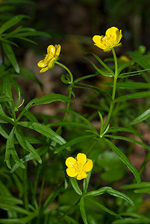|
||||||
|
RANUNCULUS. Buttercups, Spearworts and Crowfoots. [Ranunculaceae] |
|
|
Twenty-seven species of Ranunuculus are recorded in Britain. These include the native Meadow Buttercup (R. acris), Goldilocks Buttercup (R. auricomus), Bulbous Buttercup (R. bulbosus), Lesser Celandine (R. ficaria), Lesser Spearwort (R. flammula), Greater Spearwort (R. lingua) and Creeping Buttercup (R. repens). The BSBI provide a downloadable plant crib for water crowfoots and buttercups. Ranunculus ficaria is treated as Ficaria verna by Stace (2010). Adder's-toungue Spearwort (R. ophioglossifolius) is protected under Schedule 8 of the Wildlife and Countryside Act, 1981. River Water-crowfoot (R. fluitans) is protected in Northern Ireland under Schedule 8 of the Wildlife (Northern Ireland) Order, 1985. Twelve British miners are recorded on Ranunuculus. The agromyzid Phytomyza nigritula is recorded as a stem-borer on Ranunculus. The agromyids Phytomyza evanescens and Phytomyza nigritula feed as internal stem-borers of Ranunculus in Britain (Spencer, 1972). The agromyzid Phytomyza albipennis possibly feeds as an internal stem-borer of Ranunculus in Britain (Spencer, 1972). A key to the European miners recorded on Ranunculus is provided in Bladmineerders van Europa. |
|
Key for the identification of the known mines of British |
Note: Diptera larvae may live in a corridor mine, a corridor-blotch mine, or a blotch mine, but never in a case, a rolled or folded leaf, a tentiform mine or sandwiched between two more or less circular leaf sections in later instars. Pupation never in a cocoon. All mining Diptera larvae are leg-less maggots without a head capsule (see examples). They never have thoracic or abdominal legs. They do not have chewing mouthparts, although they do have a characteristic cephalo-pharyngeal skeleton (see examples), usually visible internally through the body wall. The larvae lie on their sides within the mine and use their pick-like mouthparts to feed on plant tissue. In some corridor miners frass may lie in two rows on alternate sides of the mine. In order to vacate the mine the fully grown larva cuts an exit slit, which is usually semi-circular (see Liriomyza huidobrensis video). The pupa is formed within the hardened last larval skin or puparium and as a result sheaths enclosing head appendages, wings and legs are not visible externally (see examples). See Key to non-Diptera. |
1a > Stem or petiole miner: Mine with offshoots into the leaf blade. |
1b > Leaf-miner |
2 > Stem miner: An external stem mine. Frass is deposited at wide intervals. Pupation in the mine (Spencer, 1972b: 27; Spencer, 1976: 76). |
|
Ophiomyia ranunculicaulis Hering, 1949 [Diptera: Agromyzidae]. |
3a > Leaf-miner: The larva mines in the petiole, from where it makes corridors fanning out in the blade. The corridors are parallel-sided, little branched and almost full-depth. In fresh mine primary feeding lines are visible. Pupation outside the mine. |
|
Phytomyza stolonigena Hering, 1949 [Diptera: Agromyzidae]. |
3b > Leaf-miner: Larva forms a primary blotch at the tip of a leaf segment (Spencer, 1976: 491). A brown primary blotch that may occupy an entire leaf segment. Frass dispersed. Primary and secondary feeding lines well visible. Pupation within the mine. |
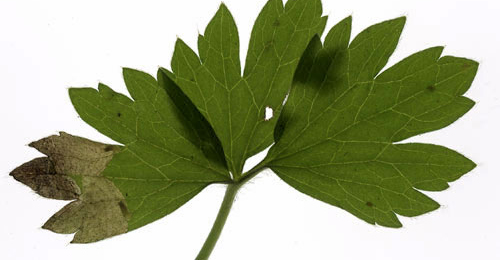 Mine of Phytomyza rydeni on Ranunculus acris Image: © Willem Ellis (Bladmineerders van Europa) |
|
Phytomyza rydeni Hering, 1934 [Diptera: Agromyzidae]. |
3c > Leaf-miner: Larva forms a linear mine, normally at the apex of leaf, winding backwards and forwards and thus forming a secondary blotch which quickly turns brown. Pupation internal (Spencer, 1976: 415). A compact secondary blotch, without islands of unmined green tissue. Mines usually dirty brown in colour, strikingly resembling a dead and rotting leaf segment. Both primary and secondary feeding lines apparent. Frass partly in long strings. Pupation takes place within the leaf, in a lower-surface puparial chamber, often somewhat removed from the mine itself. |
|
Phytomyza fallaciosa Brischke, 1880 [Diptera: Agromyzidae]. |
3d > Leaf-miner: Long, upper-surface corridor with the frass in relatively large, widely dispersed fragments. Pupation outside the mine; exit slit in lower epidermis. Forms an elongated linear mine with the frass grains are widely spaced, which enables distinction between this species and P.ranunculi, where the frass is in closely adjoining grains. Pupation is external. |
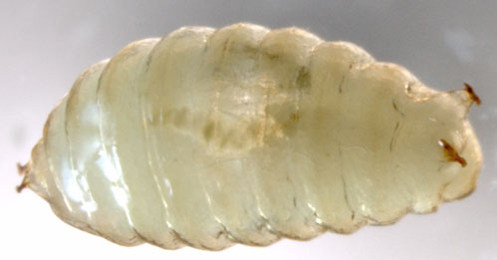 Phytomyza ranunculivora puparium Image: © Willem Ellis (Bladmineerders van Europa) |
|
Phytomyza ranunculivora Hering, 1932 [Diptera: Agromyzidae]. |
3e > Leaf-miner: Larva forms a conspicuous white linear mine with frass in closely adjoining grains. Pupation external (Spencer, 1972b:70 (figs 229-230A), 75; Spencer, 1976: 481, 483 (figs. 846, 848A)). Rather long, somewaht untidy, upper-surface corridor. Frass in many small grains that are close together of form pearl chains. Pupation outside the mine. The frass, in the long upper-surface white corridor, look like strings of pearls. P.ranunculivora makes similar long linear mines but in this species the frass grains are separate. The mine is also illustrated in the Encyclopedia of Life. |
 Phytomyza ranunculi puparium Image: © Willem Ellis (Bladmineerders van Europa) |
|
Phytomyza ranunculi (Schrank, 1803) [Diptera: Agromyzidae]. |
3f > Leaf mine: A secondary blotch near the apex of a leaf segment which develops from short, adjoining sections of a linear mine. Pupation takes place in the mine (Spencer, 1976: 482). A compact secondary blotch, without islets of unmined tissue. Mine without brown discoloration. Both primary and secondary feeding lines recognisable. Pupation within the leaf, in a lower-surface section of the mine. |
|
Phytomyza ranunculicola Hering, 1949 [Diptera: Agromyzidae]. |
3g > Leaf-miner: Mine short, broad, essentially linear, sometimes with a small brown patch at beginning. Pupation external (Spencer, 1972b: 70 (fig. 228), 73); Spencer, 1976: 459 (fig. 806), 460). A short, broad corridor, with irregular sides. The mine often starts at a browned spot in the centre of the leaf. Pupation outside the mine. |
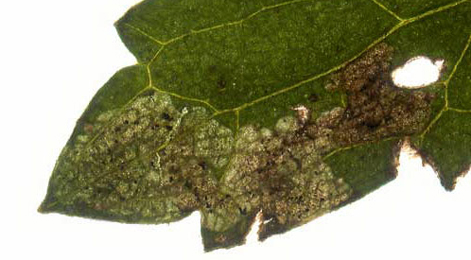 Mine of Phytomyza notata on Ranunculus acris Image: © Willem Ellis (Bladmineerders van Europa) |
|
Phytomyza notata Meigen, 1830 [Diptera: Agromyzidae]. |
3h > Leaf-miner: Full depth, initially a much branched corridor, irregular in width, in the end almost a blotch. The mine has openings by which part of the frass is ejected. The larvae frequently leave the mine to restart elsewhere. Older larva live free and cause window feeding, often erasing their old mines. In Coltsfoot also pseudo-mines are made, when the larva eats away the lower epidermis with the leaf tissue, but spares the dense hair cover. |
|
Phytosciara halterata Lengersdorf, 1926 [Diptera: Sciaridae]. |
| 3i > Leaf-miner: Small, full-depth mine, sometimes strongly branched and corridor-like, more blotchy at other occasions. As a rule a number of mines in a leaf. A larva makes several mines. Pupation external. |
|
Ctenosciara hyalipennis (Meigen, 1804) [Diptera: Sciaridae] |
|
Key for the identification of the known mines of British |
Note: The larvae of mining Coleoptera, Hymenoptera and Lepidoptera may live in a corridor mine, a corridor-blotch mine, a blotch mine, a case, a rolled or folded leaf, a tentiform mine or sandwiched between two more or less circular leaf sections in later instars. Larva may pupate in a silk cocoon. The larva may have six legs (although they may be reduced or absent), a head capsule and chewing mouthparts with opposable mandibles (see video of a gracillarid larva feeding). Larvae of Hymenoptera and Lepidoptera usually also have abdominal legs (see examples). Frass, if present, never in two rows. Unless feeding externally from within a case the larva usually vacates the mine by chewing an exit hole. Pupa with visible head appendages, wings and legs which lie in sheaths (see examples). |
1a > Leaf-miner: In the first instar the larva mines the leaves, forming short, irregular, blotch-like mines, but in later instars it lives externally, feeding in spun leaves and often twisting those of tender shoots. Larval head light-brown or yellowish brown, edged with black postero-laterally, ocellar area blackish; prothoracic plate black edged with whitish anteriorly; abdomen dull dark green; pinacula distinct, black, sometimes brownish but with black bases to setae; anal plate large, black (Bradley et al., 1973). Small, full depth mine without a definite shape; little frass. Some silk is deposited in the mine. The larva soon leaves the mine and continues feeding among spun leaves. |
|
Cnephasia incertana (Treitschke, 1835) [Lepidoptera: Tortricidae]. |
1b > Leaf-miner: Rather narrow corridor, untidy and sometimes branched, starting from the base of the leaf, in particular the midrib. Sides of the corridor irregularly eaten out, not really parallel. Frass mostly present, and then in a central line. The larva is capable of leaving the mine and start a new one elsewhere. These later mines are much broader, and the frass is scattered irregularly.. |
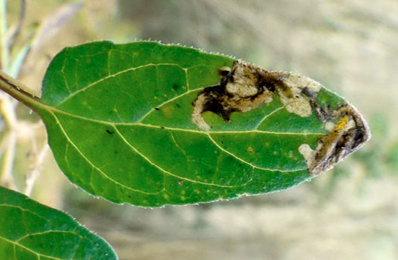 Mine of Orthochaetes insignis on Prunella vulgaris Image: © Jean-Yves Baugnée (Bladmineerders van Europa) |
|
| Orthochaetes insignis (Aube, 1863) [Coleoptera: Curculionidae]. |
1c > Leaf-miner: Large glassy blotch, beginning as a short full depth corridor along the leaf margin Mine in the tip of a leaf segment. The leaf tissue around the mine often turning dark purple. Much, coarse, frass. Pupation outside the mine. The larvae of sawflies have at least six thoracic legs (although they may be reduced or absent), a head capsule and chewing mouthparts with opposable mandibles but no abdominal legs. |
|
Pseudodineura fuscula (Klug, 1816) [Hymenoptera: Tenthredinidae]. |
| Last updated 06-Jul-2019 Brian Pitkin | ||

